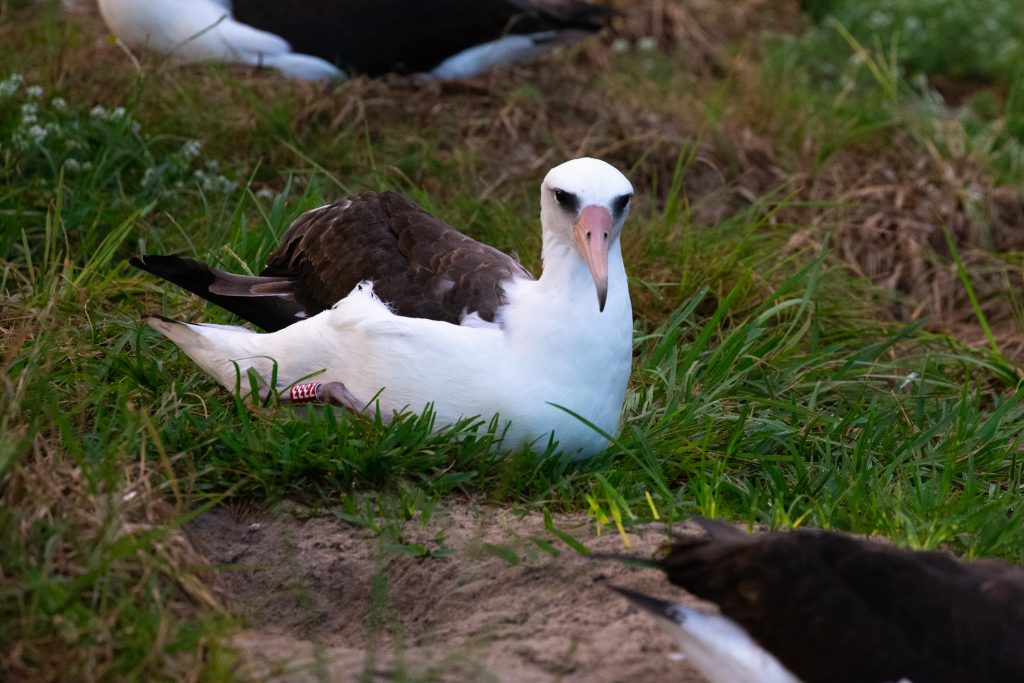 |
| She's back, and you can even see her red plastic band number (Z333) |
For the past decade or so, every year right around my birthday in November, I obsessively do a Google search at least three or four times every day, hoping desperately for good news from Midway Island in the Pacific. I don’t rest easily until I know that a Laysan Albatross named Wisdom, the only wild bird known to be older than me, has returned to her nesting territory. She was originally banded, as a breeding adult, by Chandler Robbins on December 10, 1956.
For decades after that, no one paid much attention to her, but when Robbins returned to Midway Island in 2011, he started wondering if the nesting colony included any birds that he’d banded so long before. Albatrosses fly roughly 50,000 miles each year, mostly low over salt water, and get all their food and rest swimming in salt water, so their bodies are better designed to withstand salt-water corrosion than the original aluminum US Fish and Wildlife Service leg bands Robbins used. When already-banded albatrosses are recaptured, aluminum bands often need to be replaced. Sometimes they're too corroded to be legible, obliterating the personal history of a banded bird, so albatross bands now are made of sturdy plastic. When the number on an aluminum band is still legible when the band is replaced, the old number is recorded on the new banding record.
Many of the Midway Island albatrosses were originally banded, and sometimes rebanded, long before banding records were computerized. Every banding encounter was recorded on a single card, and it wasn’t easy to trace backwards. But going through the cards at the Bird Banding Laboratory in Patuxent, Maryland, in 2011, Robbins learned that the bird wearing a bright red plastic band numbered Z333 had been wearing an aluminum band that was replaced by that new band. He tracked down that number—it was also a recapture—and tracked down the previous number. It turns out that Z333 had been recaptured and banded five times after Robbins originally banded her, and fortunately, each of those old bands was still legible when it was replaced. Robbins was thrilled that at least one of his original banded birds was still alive, and a minimum of 60 years old—that made the news, and people started calling her Wisdom and wondering just how long beyond that improbable age she’d survive.
For a merciful stretch of years, a day or two after a biologist confirmed by her leg band that she was back, a news release went out. Tragically for my peace of mind, the pandemic has changed priorities. This year, she was first seen and verified at her Midway nest site on November 26, but the US Fish and Wildlife Service press release didn’t go out until December 15. By then I was almost resigned to her not returning.
Laysan Albatrosses hatch in late January or February, virtually all of them under the sign of Aquarius, with a few late hatchings being Pisces. Albatrosses don’t believe in such silliness, but it’s fun to think about Pisces being a water sign, because water is where albatrosses obtain 100 percent of their food. Aquarius is an air sign, and albatrosses spend the vast majority of their lives aloft. They come to land only to nest each year, and it's beautifully appropriate that Aquarius is symbolized by the Water Bearer who brings essential nutrients, in this case albatross babies, from water to earth.
Anyway, Wisdom may be 70 right now, about to turn 71 on her coming hatch day. But although they are hormonally and physically capable of breeding starting at 5 years old, few young female albatrosses manage to actually attract a mate and start nesting at that young age. Indeed, many females don’t breed for the first time until they’re 10. And there is no way of knowing whether 1956 was the year of Wisdom’s first nesting attempt or her 20th. Albatrosses aren’t forthcoming about their ages, so all we can be certain of is that Wisdom is a minimum of 70 years old.
She won’t be breeding this year—she left the nest area on December 5 to return to the sea. So ten days before I even knew she'd come back to the island she was already gone for the year. Raising young involves a 7–8-month commitment, the pair taking turns on land and sea, one parent fasting as it incubates the egg or tends the chick while the other is feeding out on the ocean. After the chick hatches, the one at sea is literally eating for two, pigging out for a day or more only to return to the nest to regurgitate much of that food to the hungry, growing chick. That makes the nesting season physically depleting for both the father and mother, and the mother also must expend all the nutrients needed to develop and lay the egg in the first place. This is why Laysan Albatrosses seldom nest two years in a row.
Being almost her age, as much as I love spending time with my baby grandson, I appreciate that need for an occasional break from childcare. There's no way of tracking Wisdom on the open ocean, so it won't be until next December, when a new nesting season begins, that I'll start worrying again. But for now, I’m thrilled with the certainty that Wisdom is alive and well.
